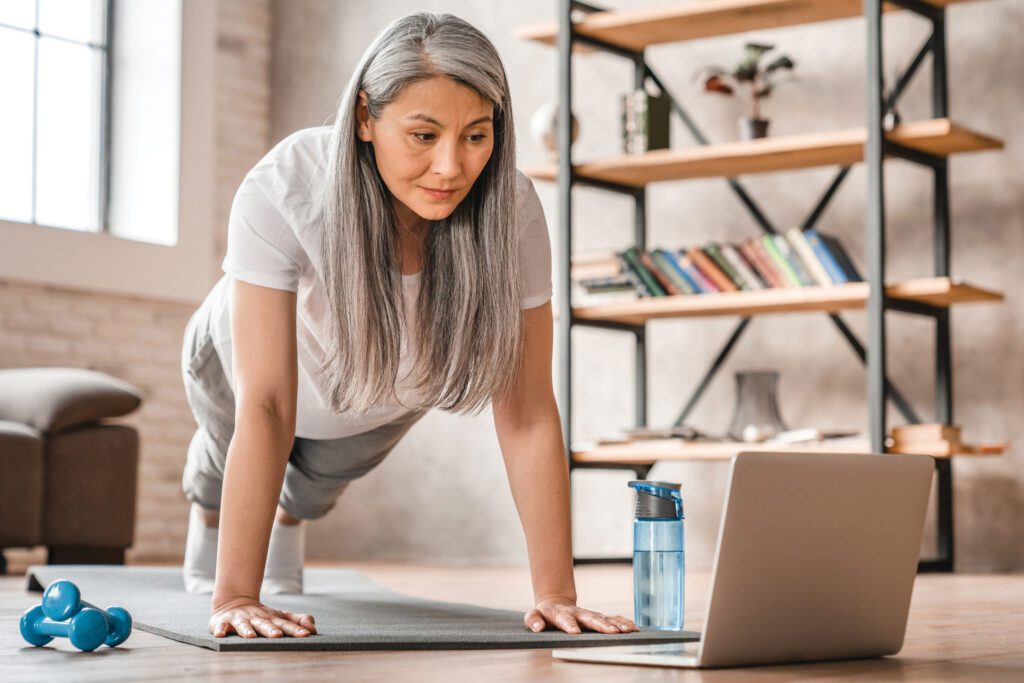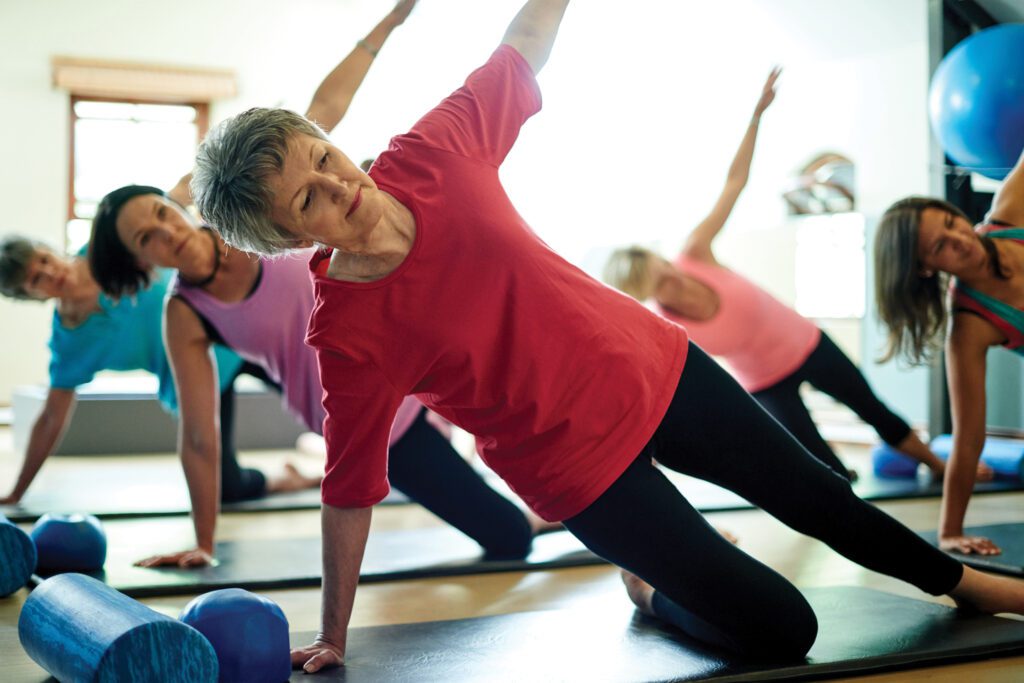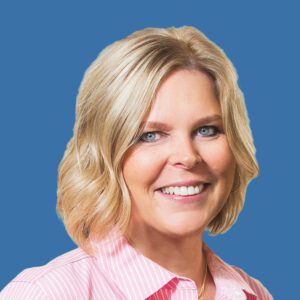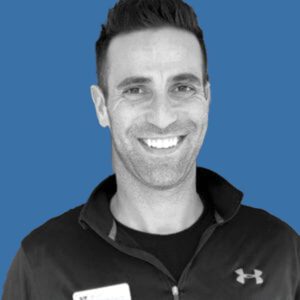Importance of Maintaining Mobility
Keeping your muscles limber is the single most important thing you can do to enjoy your senior years. This year, make sure improving flexibility remains at the top of your to-do list.
Why Flexibility Matters
Flexibility is often overlooked as a key factor in aging well, though its importance touches all aspects of your life. First and foremost, it affects your daily activities, from reaching items on high shelves to changing sheets on the bed, where stretching and bending are part of the task. ”A lack of flexibility makes even the simplest daily activities, such as tying your shoes, more difficult to do, and not addressing the issue at all will lead to reduced mobility over time,” says Alisha Landes, executive director of The Lantern at Morning– Pointe.
Flexibility works in tandem with stress and pain relief. Simple stretching and deep breathing help relieve stress, and methodical loosening of the muscles through stretching is relaxing.


Stretching is also useful in alleviating muscle cramping and pain. Without it, muscles will start to shrink and lose their fibers, leaving them feeling tight or cramped.
Even your posture is closely tied to your level of flexibility. Tendons lose their water content if left unused, which can cause you to hunch over or slouch. Maintaining flexibility through stretching will help support good posture and keep the body aligned and relaxed. This, in turn, aids breathing and lung capacity as well as circulation.
Flexibility even helps keep you upright, so your muscles can react quickly to a trip on the stairs or accidental misstep. “The injury risk, in general, lowers with increased flexibility,” says Landes, “but in the case you suffer a fall, the more flexible you are, the easier the fall is on your body.” Limber muscles and tendons help protect bones and joints should you take a fall.
If you lead a fairly sedentary lifestyle, you can anticipate ongoing muscle loss, as well as decreasing stamina, range of motion, and strength with each passing year. Even if you are somewhat active, certain behaviors – like sitting in a desk chair all day and leaning forward – will shorten your muscles, making them more likely to develop strains or tears. “For those who have had years of sedentary living and poor posture, a structured sequence of stretching and exercises that can be practiced daily may be the best way to regain range of movement,” explains Bruno Martins, personal training coordinator at the Downtown Family YMCA.
Dynamic vs. Static Stretching
There are different types of stretching, referred to as dynamic and static, that can help you achieve different results. Dynamic stretching is an effective way to warm up for another activity, like running or playing tennis, and it decreases the risk of injury significantly.
Some dynamic exercises that prepare you well for many activities include slow shoulder circles that rotate the shoulders forward or backward for 30 seconds; a trunk rotation, where you twist your upper body side-to-side while standing on the balls on your feet; or the classic lunge: with a straight back take a large step forward and lower until your front thigh is parallel to the ground and back knee is bent, resting just above the ground.
Static stretching is typically used after exercise, as it may inhibit the muscle’s ability to work harder. It’s also the best option for someone living a more sedentary lifestyle. “Static means ’parked’ or ‘stationary,’ and movements are made to isolate one muscle group at a time,” says Martins.



For those who have had years of sedentary living and poor posture, a structured sequence of stretching and exercises that can be practiced daily may be the best way to regain range of movement.”
Two good static examples are the frog stretch, where you turn your feet out and squat as low as possible with your heels on the ground, or the quad stretch: pulling and holding one foot up behind you while pushing your hips forward and standing on one leg. For static stretches, 30-60 seconds per stretch is enough to see improvement, and three reps of each can reap big dividends.
Knowing When Enough Is Enough
Remember that the point of stretching is to improve flexibility, not to win an international flexibility trophy! You should always be able to talk and breathe while stretching. If you find yourself holding your breath, back off a bit and relax.
Your muscles shouldn’t tremble while you’re stretching either: that indicates that you’re stretching too intensely. Ease off until you feel only a gentle tug, but no pain or burning in the muscle. “When you’re starting or progressing with a new program, you should ease into the activity until the first point of resistance,” says Martins. “Pain is a signal from your body to back off and relax or completely stop the stretch.”
As with all changes in exercise, consult your medical professional before beginning anything vigorous. You need to begin slowly and work up to increased flexibility. Doing a few stretches gently every day is quite effective without being risky. Find stretches that target an area that feels tight, and build up your range of motion over time.
You might want to try a senior-oriented yoga class to help you get started. Many area organizations offer low-cost gentle yoga classes that focus primarily on stretching to feel better. Feeling accountable to friends in a class might help you get started and stay motivated. If you prefer exercising alone, there are scores of videos available online that can walk you through a practice at virtually any preferred speed. “Exercise doesn’t have to be hard to be effective,” reminds Landes. “Don’t be fooled into thinking that you have to work out an hour a day, five days a week to make a difference. Simply living a more active lifestyle will help you reduce muscle loss while maintaining your stamina, strength, balance, range of motion, and flexibility.”
The best way to feel better – and enjoy the highest possible quality of life as you age – is to get out of your chair! Being active in many different ways is the most reliable way to maintain a flexible and strong mind and body.



Alisha Landes
Executive Director, The Lantern at Morning Pointe



Bruno Martins
Personal Training Coordinator, Downtown Family YMCA

